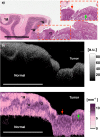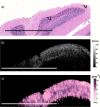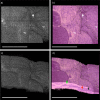Measuring the optical characteristics of medulloblastoma with optical coherence tomography
- PMID: 25909030
- PMCID: PMC4399685
- DOI: 10.1364/BOE.6.001487
Measuring the optical characteristics of medulloblastoma with optical coherence tomography
Abstract
Medulloblastoma is the most common malignant pediatric brain tumor. Standard treatment consists of surgical resection, followed by radiation and high-dose chemotherapy. Despite these efforts, recurrence is common, leading to reduced patient survival. Even with successful treatment, there are often severe long-term neurologic impacts on the developing nervous system. We present two quantitative techniques that use a high-resolution optical imaging modality: optical coherence tomography (OCT) to measure refractive index, and the optical attenuation coefficient. To the best of our knowledge, this study is the first to demonstrate OCT analysis of medulloblastoma. Refractive index and optical attenuation coefficient were able to differentiate between normal brain tissue and medulloblastoma in mouse models. More specifically, optical attenuation coefficient imaging of normal cerebellum displayed layers of grey matter and white matter, which were indistinguishable in the structural OCT image. The morphology of the tumor was distinct in the optical attenuation coefficient imaging. These inherent properties may be useful during neurosurgical intervention to better delineate tumor boundaries and minimize resection of normal tissue.
Keywords: (100.2960) Image analysis; (110.4500) Optical coherence tomography; (170.6935) Tissue characterization; (290.1350) Backscattering.
Figures







Similar articles
-
Nondestructive label-free detection of peritumoral white matter damage using cross-polarization optical coherence tomography.Front Oncol. 2023 Mar 2;13:1133074. doi: 10.3389/fonc.2023.1133074. eCollection 2023. Front Oncol. 2023. PMID: 36937429 Free PMC article.
-
Differentiation between normal and tumor mammary glands with depth-resolved attenuation coefficient from optical coherence tomography.Biomed Phys Eng Express. 2021 Nov 18;8(1). doi: 10.1088/2057-1976/ac37ca. Biomed Phys Eng Express. 2021. PMID: 34753120
-
Optical coefficients as tools for increasing the optical coherence tomography contrast for normal brain visualization and glioblastoma detection.Neurophotonics. 2019 Jul;6(3):035003. doi: 10.1117/1.NPh.6.3.035003. Epub 2019 Jul 16. Neurophotonics. 2019. PMID: 31312669 Free PMC article.
-
Parametric imaging of attenuation by optical coherence tomography: review of models, methods, and clinical translation.J Biomed Opt. 2020 Apr;25(4):1-34. doi: 10.1117/1.JBO.25.4.040901. J Biomed Opt. 2020. PMID: 32246615 Free PMC article. Review.
-
Review of methods and applications of attenuation coefficient measurements with optical coherence tomography.J Biomed Opt. 2019 Sep;24(9):1-17. doi: 10.1117/1.JBO.24.9.090901. J Biomed Opt. 2019. PMID: 31520468 Free PMC article. Review.
Cited by
-
A cerebellar window for intravital imaging of normal and disease states in mice.Nat Protoc. 2017 Nov;12(11):2251-2262. doi: 10.1038/nprot.2017.101. Epub 2017 Oct 5. Nat Protoc. 2017. PMID: 28981123 Free PMC article.
-
Deep learning architecture "LightOCT" for diagnostic decision support using optical coherence tomography images of biological samples.Biomed Opt Express. 2020 Aug 13;11(9):5017-5031. doi: 10.1364/BOE.395487. eCollection 2020 Sep 1. Biomed Opt Express. 2020. PMID: 33014597 Free PMC article.
-
Label-free optical imaging for brain cancer assessment.Trends Cancer. 2024 Jun;10(6):557-570. doi: 10.1016/j.trecan.2024.03.005. Epub 2024 Apr 4. Trends Cancer. 2024. PMID: 38575412 Free PMC article. Review.
-
Customized Tool for the Validation of Optical Coherence Tomography in Differentiation of Prostate Cancer.Technol Cancer Res Treat. 2017 Feb;16(1):57-65. doi: 10.1177/1533034615626614. Epub 2016 Jul 7. Technol Cancer Res Treat. 2017. PMID: 26818025 Free PMC article.
-
Visualizing and mapping the cerebellum with serial optical coherence scanner.Neurophotonics. 2017 Jan;4(1):011006. doi: 10.1117/1.NPh.4.1.011006. Epub 2016 Sep 30. Neurophotonics. 2017. PMID: 27725947 Free PMC article.
References
-
- Gajjar A., Hernan R., Kocak M., Fuller C., Lee Y., McKinnon P. J., Wallace D., Lau C., Chintagumpala M., Ashley D. M., Kellie S. J., Kun L., Gilbertson R. J., “Clinical, histopathologic, and molecular markers of prognosis: toward a new disease risk stratification system for medulloblastoma,” J. Clin. Oncol. 22, 984–993 (2004).10.1200/JCO.2004.06.032 - DOI - PubMed
-
- Kumar V., Abbas A. K., Fausto N., Aster J. C., Robbins and Cotran Pathologic Basis of Disease, Professional Edition: Expert Consult-Online, 8 (Elsevier Health Sciences, 2009).
LinkOut - more resources
Full Text Sources
